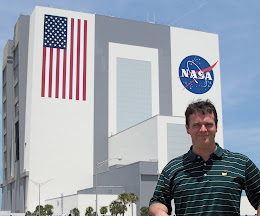ATLANTA -- Climbing aboard a sleek Air Force fighter jet and launching into the deep blue sky can make one either grin or become ill -- for this aerospace journalist punching that sky in an aerobatic jet was an incredible feeling.
To soar with the U.S. Air Force Thunderbirds was a dream come true as I welcomed the chance to chase the sound barrier and pull nearly 8G's in a Lockheed Martin-built F-16D Fighting Falcon.
The Thunderbirds are known as America's Ambassadors in Blue and they live up to the title inspiring young men and women across the country to reach for their goals in education and technical training by serving in the Air Force. They perform to support recruitment in the Air Force; to represent the U.S. armed forces to the nations across the globe; and give American citizens a self fulfilled confidence in their military.
In his third year with the team, Thunderbird 8 is Major Michael Fisher, a native of Vancouver, Washington. He has logged 432 combat hours in the F-16 and over 2000 hours as a pilot. During the 2014 season, he serves as the Thunderbirds' air show narrator announcing the aerobatic demos as the teams soars over the crowds.
My flight day began at dawn at Dobbins Air Reserve Base located northwest of metro Atlanta. Dobbins is home to the Airmen of the 94th Air Wing division and supports military operations such as aircraft fueling and logistics. On this cool October morning, Dobbins is where my jet stood poised for flight.
Monday, October 20, 2014
Monday, October 06, 2014
Telescopes stand poised for Wednesday's total lunar eclipse
Backyard astronomers and public observatories across America will have telescopes trained on a total lunar eclipse Wednesday as the Earth passes between the Sun and the Moon in a rare celestial event.
The Sun, Earth and Moon will align forcing our home planet to block the Sun's rays from reaching our lunar neighbor. The full Moon will take on an eerie reddish glow as the light is scattered through our atmosphere giving it the name Blood Moon.
Along the eastern coast of the U.S., the Moon will begin to set just after 7:10 a.m. EDT, providing three hours of lunar observation prior to Moon set in many areas. Clear to partly cloudy skies are also in the forecast for much of the United States.
"Look towards the west and you will see the full moon with a bite taken out of it - this is the lunar eclipse in progress," Atlanta's Tellus Science Museum astronomer David Dundee said on Monday. "Wednesday morning the Moon will enter the shadow of the Earth. By 6:24 a.m., the Moon will be totally in the shadow of the Earth it may turn a copper or reddish color.“
NASA Goddard Space Flight Center released an astronomers information sheet in support of times and locations to best view the second lunar eclipse of 2014. The space agency will host an online discussion and provide live video of the eclipse beginning at 3:00 a.m. and continuing until sunrise. NASA lunar experts will reach out to chat on social media as they seek reports from the public and lunar photography.
Several observatory's and museums will open before dawn to mark the occasion. Children waiting in line at the bus stop may have the chance to view the astronomical show.
“Since the eclipse begins a little after 4 a.m., we are hoping guests will join us at the museum before work or school for this magnificent opportunity to see a Total Lunar Eclipse in a fun and unique way," Tellus spokesperson Shelly Redd said on Monday. "The museum opens at 5:00 a.m. and will remain open after the eclipse is complete."
(Charles Atkeison reports on aerospace, science and technology. Follow his updates via Twitter @AbsolutSpaceGuy.)
The Sun, Earth and Moon will align forcing our home planet to block the Sun's rays from reaching our lunar neighbor. The full Moon will take on an eerie reddish glow as the light is scattered through our atmosphere giving it the name Blood Moon.
Along the eastern coast of the U.S., the Moon will begin to set just after 7:10 a.m. EDT, providing three hours of lunar observation prior to Moon set in many areas. Clear to partly cloudy skies are also in the forecast for much of the United States.
"Look towards the west and you will see the full moon with a bite taken out of it - this is the lunar eclipse in progress," Atlanta's Tellus Science Museum astronomer David Dundee said on Monday. "Wednesday morning the Moon will enter the shadow of the Earth. By 6:24 a.m., the Moon will be totally in the shadow of the Earth it may turn a copper or reddish color.“
NASA Goddard Space Flight Center released an astronomers information sheet in support of times and locations to best view the second lunar eclipse of 2014. The space agency will host an online discussion and provide live video of the eclipse beginning at 3:00 a.m. and continuing until sunrise. NASA lunar experts will reach out to chat on social media as they seek reports from the public and lunar photography.
Several observatory's and museums will open before dawn to mark the occasion. Children waiting in line at the bus stop may have the chance to view the astronomical show.
“Since the eclipse begins a little after 4 a.m., we are hoping guests will join us at the museum before work or school for this magnificent opportunity to see a Total Lunar Eclipse in a fun and unique way," Tellus spokesperson Shelly Redd said on Monday. "The museum opens at 5:00 a.m. and will remain open after the eclipse is complete."
(Charles Atkeison reports on aerospace, science and technology. Follow his updates via Twitter @AbsolutSpaceGuy.)
Tags:
astronomy,
Atkeison,
Blood Moon 2014,
NASA,
telescopes
Subscribe to:
Posts (Atom)





